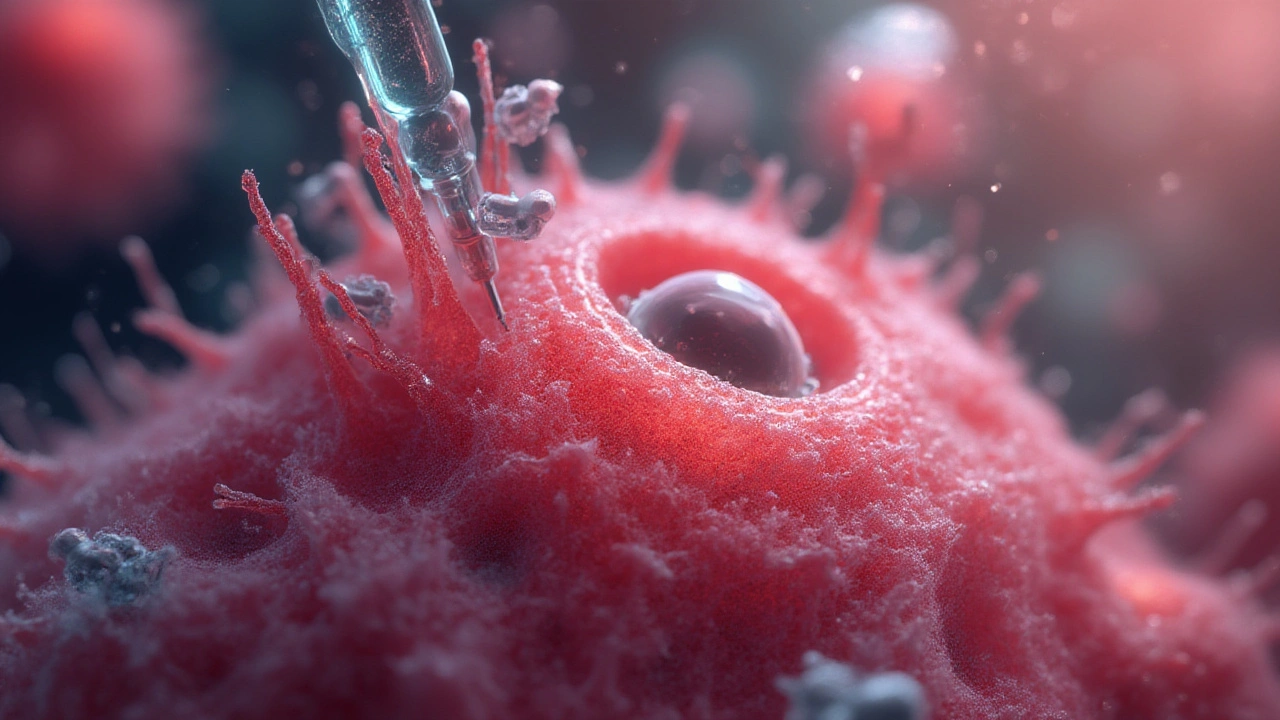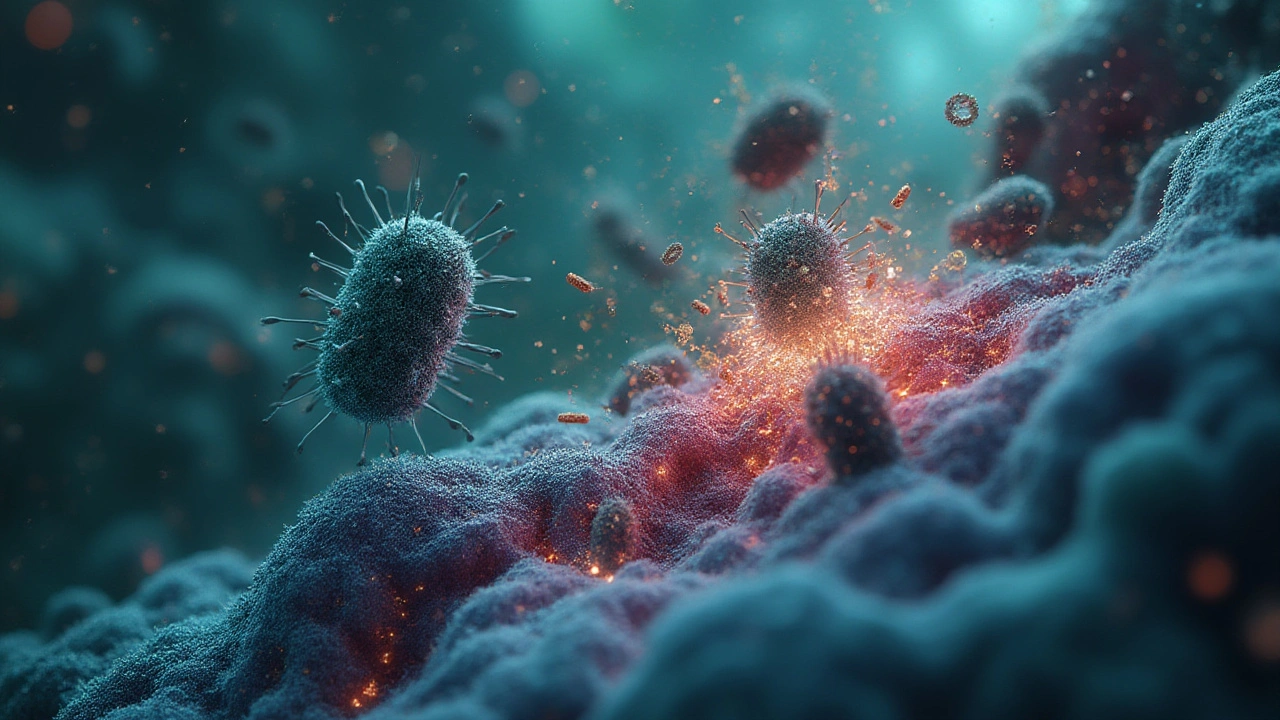Imagine a microscopic arms race happening all over your body—right now. Bacteria aren’t just passive hitchhikers floating along for the ride. They come prepared, equipped with sophisticated tools called virulence factors, letting them shatter your natural defenses, attack your cells, and multiply long before you notice an infection brewing. These tiny troublemakers use a blend of slippery disguises, stealthy attacks, and powerful toxins that can leave even the hardiest immune systems scrambling to keep up.
Toxins: The Bacterial Arsenal that Strikes from Within
Let’s get real—bacteria want what you’ve got. Your nutrients, your cells, your warmth. So, they deploy toxins like skilled saboteurs, disrupting vital cellular processes while staying sneaky. The range of bacterial toxins is mind-blowing. Some, like the diphtheria toxin, simply force a cell to stop making proteins altogether. It’s no wonder this one, back before vaccines, used to shock parents with its rapid and deadly effects. Others, like the infamous botulinum toxin from Clostridium botulinum, are so potent that a dose the size of a grain of sand can be fatal. In fact, botulinum toxin holds the title for the most toxic substance known to humanity.
Not all toxins are equally destructive. Some bacteria release enterotoxins, stirring chaos in the gut. Take the case of Vibrio cholerae—the culprit behind cholera. Its secret weapon, cholera toxin, hijacks your intestinal cells and forces them to dump gallons of water and electrolytes, causing the severe, watery diarrhea cholera is notorious for. Without rapid rehydration, this can be deadly, especially in children.
Other toxins, like cytotoxins, poke holes in cell membranes. Staphylococcus aureus is notorious for its alpha-toxin, which bursts red and white blood cells open, disrupting both oxygen delivery and your immune response. And then there’s the AB toxin group (named for their A and B subunit structure): B subunits ferry the destructive A subunit right into the host cell. Shigella uses an AB toxin called Shiga toxin—which can cause potentially lethal complications like hemolytic uremic syndrome, especially in children exposed to contaminated food or water.
Bacteria also use toxins to bust open entire tissues for easier invasion. For example, Clostridium perfringens produces gas gangrene’s main toxin, alpha-toxin. This one acts as both a lipase and hemolysin, helping the bacteria speed through muscle tissue while leaving gas as a nasty byproduct.
If you want to dig into the nitty-gritty, there’s a useful resource on the bacteria infection mechanism that breaks down how these toxins actually cripple the body during infection, with diagrams and case examples that show how quickly things can escalate.
| Toxin Type | Producer | Main Effect | Known Disease(s) |
|---|---|---|---|
| Botulinum toxin | Clostridium botulinum | Blocks nerve function | Botulism |
| Diphtheria toxin | Corynebacterium diphtheriae | Halts protein synthesis | Diphtheria |
| Cholera toxin | Vibrio cholerae | Triggers electrolyte loss | Cholera |
| Shiga toxin | Shigella dysenteriae, some E. coli | Damages blood vessels | Shigellosis, E. coli O157:H7 infections |
Wondering why antibiotics sometimes make things worse? Certain bacteria release even more toxins when they’re killed—think E. coli O157:H7 and its Shiga toxins, which spike after antibiotic treatment and can rapidly worsen kidney damage. Doctors often steer clear of antibiotics altogether in these cases to avoid giving the bacteria a last hurrah.
Quick tip: Sanitize surfaces in the kitchen, cook meats thoroughly, and wash your hands before eating—simple steps, but they seriously cut down your risk for exposure to these sinister toxins.

Capsules: The Cloaking Device Hiding Bacteria from Your Immune System
Bacteria’s trickiest move? Going full stealth mode. The capsule is their best tool for this. Microscopic but mighty, these gel-like shells made from polysaccharides or sometimes proteins stick tight to the outer surface of the bacteria. The result? A slippery, almost invisible outer layer that even your most determined immune cells struggle to grab onto.
Take Streptococcus pneumoniae, master of the capsule game. Before routine vaccines, this single pathogen caused endless cases of pneumonia, meningitis, and ear infections. Strains covered in thick, sugary capsules are the real bullies. They dodge phagocytes—those white blood cells tasked with gobbling up invaders. What’s wild is how capsules come in different “flavors,” called serotypes. The immune system may recognize one, but not the dozens of others, allowing these bacteria to wiggle past vaccine-induced immunity unless vaccines are updated.
Bacteria without capsules? They’re often sitting ducks. Once the immune system gets a grip, these stripped-down versions don’t stand a chance and get cleared fast. Encapsulated versions, though, not only resist attack—they also swim right through your bloodstream and tissues. Think about how Neisseria meningitidis’s capsule lets it rattle around in the blood, jump into cerebrospinal fluid, and cause life-threatening meningitis in just a matter of hours.
Capsules play it smart. They mimic human tissues—this mimicry fools your immune defenses, reducing inflammation and avoiding detection. Haemophilus influenzae, not the villain behind the flu but a prime cause of childhood meningitis before vaccines, used its capsule to slip past babies’ immature immune systems. Children under 5, with immune systems still honing their skills, were especially at risk before the Hib vaccine slashed rates dramatically.
There’s another layer to the capsule’s superpowers—community defense. When bacteria with capsules stick together, they form biofilms, those slimy masses you see on dirty teeth (dental plaque, hello). Inside a biofilm, bacteria weather attacks from antibiotics and the immune system, leading to chronic infections in places like your lungs or urinary tract. A group of researchers at the University of Copenhagen found that Pseudomonas aeruginosa biofilms in cystic fibrosis lungs resist dozens of antibiotics, forcing patients onto rotating regimens for life.
Want to lower your risk? For kids, prompt vaccination against Streptococcus pneumoniae, Neisseria meningitidis, and Haemophilus influenzae type b covers the worst offenders. And yes, brushing and flossing breaks up those biofilms—less time for capsules to rally their defenses.

Secretion Systems: High-Tech Invasion Tools and Secret Passages
If capsules hide bacteria and toxins work as blunt-force weapons, secretion systems act like high-tech hacking tools. Think of bacteria as hackers, using these systems to inject secret compounds straight into your cells or to the outside environment—all happening on a microscopic scale.
Bacteria pull this off thanks to machinery called secretion systems, which operate a little like molecular syringes. The Type III secretion system (T3SS), best studied in Salmonella and certain E. coli strains, is a favorite among hospital microbiologists. This structure acts like a nanoscale hypodermic needle, directly injecting bacterial proteins (called effectors) into the host cell. Once inside, these effectors manipulate the cell’s machinery—turning it into a petri dish for the bacteria to feed, grow, and avoid getting killed.
The havoc they cause isn’t subtle. In the gut, T3SS lets bacteria rearrange your cell skeleton—pulling the cells apart to breach the gut lining, causing severe diarrhea, cramps, and often bleeding. In more serious cases, like in Shigella infections, the system pushes past gut tissue and into the bloodstream, raising the stakes dramatically.
Bacteria don’t settle for one style. There are at least seven types of secretion systems described so far. Pseudomonas aeruginosa is infamous for using both Type III and Type VI secretion systems, which can fire toxins not just into human cells, but into rival bacteria. This helps Pseudomonas rule crowded environments like wounds or catheters, crowding out competitors and growing into stubborn, chronic infections in people with burns, diabetes, or cystic fibrosis.
What’s really wild is how secretion systems can talk to your immune system’s command center. Some effectors sabotage how your body calls in backup. Yersinia pestis, the plague bacterium, paralyzes the immune response using its T3SS, so you get raging infection before a single immune alarm bell rings. This kind of sneak attack goes a long way in making Yersinia so deadly even now.
Some bacteria even use secretion systems for survival tricks outside your body. Agrobacterium tumefaciens, for example, uses its Type IV secretion system to transfer genes into plants. Genetic engineering companies learned from this and basically borrowed the mechanism to create genetically modified crops.
Here’s a tip: Infections involving medical devices like catheters or ventilators are especially at risk for biofilm and secretion system-related pathology. Any signs of redness, swelling, or fever around an implanted device? Get it checked fast—these aggressive factors can balloon a simple problem into a full-blown emergency in less than a day.
For the stats nerds, check out this table showing prevalence rates of key infections linked to these sneaky secretion systems:
| Bacterium | Secretion System Used | Key Disease Caused | Approx. Annual U.S. Cases |
|---|---|---|---|
| Salmonella enterica | Type III | Salmonellosis | ~1.35 million |
| Pseudomonas aeruginosa | Type III/VI | Hospital-acquired infections | ~50,000 |
| Shigella species | Type III | Shigellosis | ~450,000 |
| Yersinia pestis | Type III | Plague | ~7 globally |
Secretion systems aren’t going away—these are hardwired into the DNA of bacteria that hit hardest in hospitals and the community alike. It’s why researchers are developing drugs that block secretion system function as the next potential generation of antibiotics, aiming to disable bacteria’s "hacker gear" rather than just blow them up and risk toxin release.
Bacteria’s can’t-miss combo of toxins, capsules, and secretion systems creates a game of offense and defense more complicated than most people realize. Understanding these mechanisms is not just a science class fact—it's the reason vaccines work, why certain antibiotics fail, and why routine handwashing and vaccines remain your best frontline in this invisible battle.


 Medications
Medications
Lindsey Bollig
July 18, 2025 AT 11:26This post does a great job breaking down the basics of virulence factors! It’s fascinating how bacteria have evolved these complex mechanisms—like capsules that shield them from the immune system and secretion systems that inject toxins directly into our cells. It’s a wild microscopic arms race going on inside our bodies all the time.
One thing I’d add is that understanding these factors isn’t just academic; it’s crucial for developing better antibiotics and treatments. For example, some researchers are trying to target the secretion systems directly to disarm the bacteria without killing them outright, which might reduce resistance.
Also, the tricky part is that these factors often work synergistically, making bacterial infections really hard to clear simply by boosting the immune system or using one type of drug. It’s definitely an ongoing challenge in infectious disease research!
Jillian Bell
July 18, 2025 AT 11:40Honestly, it feels like we’re just scratching the surface. These virulence factors, they're like the bacteria’s tools of manipulation, and you can’t help but wonder—what if this is all part of some grand design? Like, why just make bacteria harmful? Could there be a bigger, more sinister evolutionary force at play? The way toxins and capsules protect and enhance bacteria almost feels... engineered.
And then, think about how some of these bacteria just adapt too fast, evading our best medicines. Makes you question if we’re truly in control or just puppets in this microscopic war. I think there’s a lot they’re not telling us about the real nature of these ‘virulence factors.’
Stay vigilant folks, we might just be living in the bacterial version of a second cold war.
Daniel Buchanan
July 18, 2025 AT 12:38I agree with both points here, but something I'd stress is the importance of education about these factors for the public. Often people don’t realize just how sophisticated bacteria truly are. The capsule, for instance, acts as a sort of invisibility cloak, helping bacteria slip past immune defenses.
Also, these secretion systems aren’t all alike. Some are like highly specialized machines, targeting specific host cells or tissues. Knowing this can help shape targeted therapies which could revolutionize how we fight infections in the future.
Have any of you come across promising new approaches that specifically target these virulence mechanisms? I’d love to hear about them.
Shana Shapiro '19
July 18, 2025 AT 13:20This topic really pulls at my heartstrings because thinking about the havoc these little invaders wreak on people—especially those already vulnerable—is heartbreaking. Knowing how bacteria exploit virulence factors to hurt us makes you appreciate just how smart and tenacious these microbes are.
I’ve had friends go through really tough bacterial infections, and the struggle they faced shows how crucial it is to keep researching this. It’s not just science, it’s a fight for lives. These factors like toxins don’t just make people sick; they can destroy hope.
So every step forward in understanding these mechanisms is a beacon of hope, a chance to save someone’s future. That’s why posts like this are so meaningful.
Sierra Bagstad
July 18, 2025 AT 15:00To clarify a bit for anyone interested, virulence factors can be categorized primarily into: toxins, structural components like capsules and pili, and specialized secretion systems. Toxins can be exotoxins, which are secreted actively, or endotoxins found in the bacterial cell wall and released upon cell death.
Capsules, often polysaccharide in nature, provide protection against phagocytosis. Secretion systems (types I through VII have been described) are fascinating protein complexes that enable direct injection of proteins into host cells, disrupting normal cellular functions and aiding bacterial survival.
Not all bacteria produce all these factors, but pathogenic species often have multiple strategies simultaneously. This combinatorial arsenal is why treating infections can become complicated, especially with antimicrobial resistance.
Lena Williams
July 18, 2025 AT 16:00Have you ever wondered about the evolutionary pressures that drive bacteria to develop these complex virulence factors? I mean, it’s not like bacteria are out to harm us maliciously; it's more about survival, right? The capsules, the toxins, the secretion systems—they seem like responses to environmental stressors, like the immune system itself acting like an evolutionary hotbed.
The sheer diversity in these virulence mechanisms reflects that diversity in bacterial species and their environments. It’s almost poetic how nature designs these microscopic battles. Yet, it makes me think—how much are we unintentionally encouraging more aggressive virulence through overuse of antibiotics and poor public health practices? There’s so much interconnection here that I feel we still don’t fully grasp.
Alan Kogosowski
July 22, 2025 AT 19:00Adding a bit more technical nuance, the interplay between bacterial virulence factors and the human immune response exemplifies a co-evolutionary arms race. The capsule, for example, is not merely a physical barrier but often chemically impairs complement activation and phagocytosis. Meanwhile, secretion systems—particularly Type III and Type IV—operate akin to molecular syringes, injecting effector proteins that modulate host cell signaling pathways, effectively commandeering host defenses for bacterial advantage.
Such sophistication allows pathogens to establish persistent infections, evading immune clearance effectively. The implication for clinical microbiology is profound, as pathogenesis cannot be disentangled from this molecular interplay.
What stands out are the ongoing challenges this poses for therapeutic intervention and vaccine development, necessitating multidisciplinary approaches.
Ben Lee
August 1, 2025 AT 01:13It’s worth pointing out the practical side of this knowledge—like how identifying specific virulence factors in an infection can influence treatment decisions. For instance, if a strain has a well-characterized exotoxin, doctors could consider antitoxin therapies or close monitoring for toxin-mediated complications.
Plus, rapid diagnostics that detect virulence genes can help predict if certain antibiotics might be less effective, allowing earlier adjustments to therapy. It really underlines the need for integrating microbiological insights into everyday clinical practice to improve patient outcomes.
Does anyone know if this is something being routinely done yet outside research hospitals?
David Brice
August 9, 2025 AT 03:40Look, it’s not rocket science, folks. The virulence factors highlighted are nothing new and have been studied for decades. What annoys me is the constant overhyping of these bacterial gimmicks when the fundamental issue is poor hygiene and misuse of antibiotics.
Toxins, capsules, secretion systems—all just evolutionary tools for survival, but we have the capability to prevent infections from happening in the first place. Instead, we’re scrambling to develop new therapies as bacteria keep evolving. Talk about a never-ending cycle.
It’s time we put more emphasis on prevention rather than reacting to these so-called “tricky” infections after they take hold.
Zachary Schroer
August 12, 2025 AT 15:00Oh dear, the usual simplistic explanations on display here! Everyone reacts with wide-eyed wonder at these ‘virulence factors’ as if microorganisms just stumbled upon these magnificent adaptations by chance. Honestly, it’s borderline pathetic how humans refuse to grasp that this is a testament to microbial superiority, not some freak coincidence.
Secretion systems? Merely a biological machine perfected beyond our naive conceptions. Capsules? An elegant, ruthless defense masterstroke. You want to understand why infections get tricky? It’s because microbes laugh quietly at our feeble attempts at intervention.
Wake up, folks. This isn’t science fiction; it’s nature brutally efficient and merciless.
Stacy Whitman
August 16, 2025 AT 02:20While scientific insights into bacterial virulence are important, I worry that this obsession sometimes distracts from national public health strategies. Understanding toxins and capsules is valuable, but without robust healthcare infrastructure and preventative screening, these findings remain theoretical for many communities.
The real battle is ensuring equal access to vaccines, antibiotics, and education about hygiene to prevent these infections altogether. Too much focus on the bacteria’s tricks can inadvertently undermine the urgency of strengthening national disease control systems.
We must balance our fascination with microbial evasion tactics with commitment to tangible public health policies.